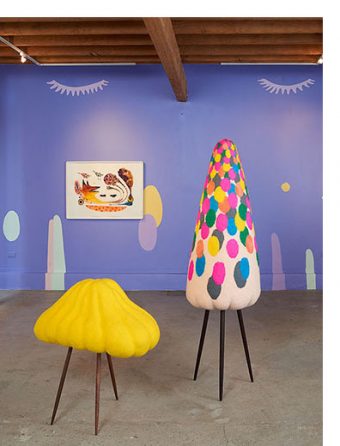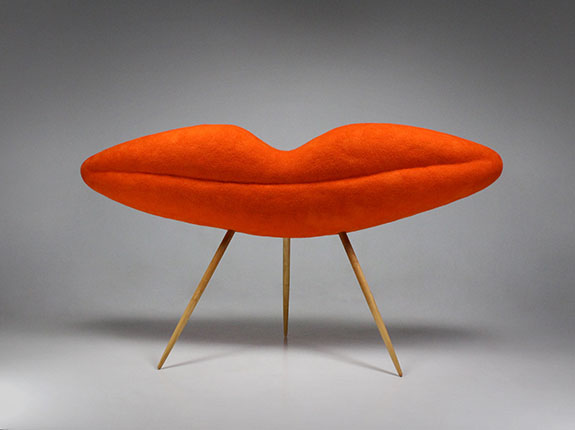by Maria Porges

In an age in which we most frequently view images on a handheld screen, the role that scale plays in our perception and appreciation might seem to be diminished. Masako Miki’s two concurrent shows — an expansive installation of sculpture (Masako Miki/ Matrix 273) at BAMPFA, and a more intimate presentation of two- and three-dimensional works (Shapeshifters) at Cult Aimee Friberg Exhibitions in San Francisco – foreground this conundrum. Miki, born and raised in Japan, has lived in the Bay Area for more than 20 years. Her work, which draws on the Shinto traditions of her native country, is shaped by the tropes of Modernism (specifically, the eccentrically organic sculpture of Isamu Noguchi) and colored by the distinctly Post-Modern flavor of the Memphis Group, a consortium of Italian furniture designers led by Ettore Sottass. There is also a hint of the lovely, spiritual whimsicality found in the animated films of Hayao Miyasaki, in whose work Shinto traditions are personified by a host of spirits.
A couple of years ago, Miki was making needle-felted sculptures to fit in the palm of one hand that she called yokai, a Japanese word meaning ghosts or phantoms capable of shifting shape. 
These works fill an entire gallery at the museum, in an installation that includes swoops and blobs of color on the floor and on walls. Their scale conjures some startling associations. Standing next to the largest work, the lumpy, eight-foot tall column that is Ichiren Bozu (animated prayer beads), I felt small, like a child. Other works suggest overgrown insects, fungi, or enormous bits of anatomy, such as eyes or lips, the latter recalling Salvador Dali’s 1936 “lip couch” and the 1970s replicas that spread like wildfire throughout the design world.
Experienced as a whole, the installation seems cheery and fun at first, but the bright colors belie a more serious idea that seems to hide beneath the fuzzy surfaces: that these are the spirits that inhabit everything, animate and inanimate. Ignore them at your own risk.
Miki describes this light-flooded gallery, filled with colorful pieces, as a “playground.” It stands in sharp contrast to the cool, blue-tinted room at Cult, where only three of the sculptures interact with several of the artist’s prismatic, semi-abstract watercolors. The
Many of Miki’s sculptural works are the size of large dog or a modest-sized piece of furniture, which is part of their effectiveness (a familiar scale) and a kind of problem, in that we have a preexisting set of assumptions and relationships with both of these things. Understanding this makes it possible to grasp Miki’s strategy. If shapeshifting is what curator Julia White describes as “a metaphor for cultural adaptation and survival,” then these objects are the occupants of the non-binary limen of our gender-fluid, biracial, multicultural world.
In both exhibitions, Miki’s painted shapes on the wall evoke portals into other realities, reinforcing a sense that we are in some kind of spiritual transit lounge. At BAMPFA, two pieces with truncated forms pressed against a wall — Nyoijizai (Grandchild’s Hands- Animated Backscratcher) and a smaller version of Ichiren-bozu (Animated Prayer Beads) — seem to be emerging or exiting, depending on your point of view. Other sculptures perch on three spindly legs, squat on the floor or hang from the ceiling on monofilament. Weaving cautiously between them brings to mind the compressed landscapes of amusement parks or casinos: the way multiple vistas are squeezed into relatively small spaces to create a deliberately overwhelming experience.

At Cult, the installation is dreamy and restful in comparison. One wall is painted violet-blue, and the room features the same long, curving arms and stylized hands that appear in the Berkeley show. Seven watercolors —accumulations of mysterious shapes on a white ground — have a melting, fragmented quality that captures the idea of shape shifting so effectively that the three sculptures take on a more mysterious air than their nearly identical twins at BAMPFA. Still, I found myself wishing that at least one of them were situated on the floor or hung from the ceiling, and not standing on the same furniture-like supports Miki used in the museum show. In images of the tiny yokai sculptures, several of which are on view through March 24 at Faultline 2.0, a pop-up curated by Jennifer Bailey Wechsler, it seems as if these tiny works are supported on toothpicks. While this formal solution for making something appear to be weightless looks great in many instances, when scaled up to the size of Miki’s new pieces, the unrelenting 
Shinto is Japan’s indigenous religion. All others— even Buddhism—are essentially grafted onto an already existing set of beliefs and traditions. Its central idea: that spirits reside in everything, from rocks and rivers to living creatures, is deeply attractive in these troubled times. Having lost our connection with (and respect for) the natural world and its power, it might help if we were able to see those spirits. At their newly enlarged scale, Miki’s yokai engage with viewers compellingly. I wished, at least for a moment, that I could exit through one of those portals into to their world.
# # #
“Masako Miki/ Matrix 273”@ BAMPFA through April 28, 2019 + Masako Miki “Shapeshifters” @ CULT Aimee Friberg Exhibitions through March 23, 2019.
About the author:
Maria Porges is an artist and writer who lives and works in Oakland. For over two decades, her critical writing has appeared in many publications, including Artforum, Art in America, Sculpture, American Craft, Glass, the New York Times Book Review and many other publications. The author of more than 100 exhibition catalog essays, she presently serves as an associate professor at California College of the Arts.